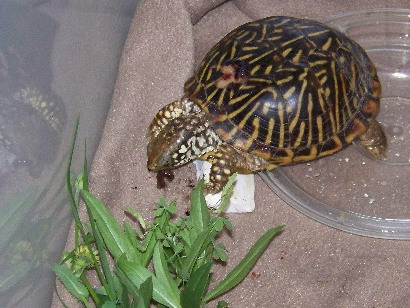Ornate Box Turtle, Terrapene ornata ornata, in Texas. (original) (raw)
Ornate Box Turtle (Terrapene ornata ornata)
Much like the barred owl of March, this feisty girl had an unfortunate run-in with a motor vehicle during an early morning sojourn. Luckily, her savior was not far behind and quickly pulled his truck over (bass boat in tow and all) and scooped her upside down form from the middle of the busy road. Aside from some cuts and scrapes, the ornate box turtle weathered the encounter comparatively well and is making a fast recovery with some tlc, antibiotics, and lots of her favorite treat: worms.

Ornate Box Turtle
Photo Dove Key Ranch Wildlife Rehabilitation
Ornate Box Turtles in Texas:
Determinedly plodding across grazed pastures, open woodlands, prairies, and sandy-soiled lowlands across Texas, ornate box turtles are so named for the distinctive yellowish lines radiating across the dark brownish to black background of their carapaces. Males sport concave plastrons, long, thick tails, and eyes marked with a brilliant red iris, a hue likewise painted across their legs and, occasionally, jaws. A large claw curves from the inner margins of each masculine rear foot, affording mounting chaps a better grip on rowdy potential mates, especially handy since female ornate box turtles are larger than similarly-aged males.
If the shelled suitor can hang on and the coupling is a success, the lively lady will seek out a protected patch of loose soil in a shaded area (often her own wintering den) to deftly bury two to eight delicate eggs between mid-May and early July. In lusher, bug-laden years, early breeders may deposit a second clutch in mid-July. Nine to ten weeks later, mini-versions of adult ornate box turtles emerge like tiny, flailing tanks from the sand, still sporting a small egg tooth that helped them crack through their brittle-shelled natal enclave. Any eggs that develop in temperatures above 84° F sprout box turtles of the fairer sex, while those incubated below 84° F cultivate male chelonians. The few turtle tykes that manage to survive a perilous world full of predators, cars, wildfires, lawnmowers, insecticides, pet collectors, and developers will reach maturity at eight to ten years of age and can prosper to a grand old age in the thirties.

The Ornate Box Turtle
Photo courtesy Dove Key Ranch Wildlife Rehabilitation
Ornate box turtles are extremely philopatric and may spend all three decades of their life in a home range as small as 0.12 hectares or as extensive as 36.4 hectares. Within this well-traversed territory, these armored omnivores recognize and remember specific landmarks for navigation ease, favorite foraging areas for refueling, potential sources of water for soaking and thirst-quenching, scrubby, shady spots for mid-day cooling, and well-drained areas for winter denning and spring nesting. Mornings draw snoozing ornate box turtles from their burrows to bask in the rising sun�s rejuvenating rays. Once the chelonians are warmed, they search for everything and anything from grasshoppers, caterpillars, earthworms, and cicadas to mulberries, blackberries, opuntia cacti, and a wide variety of vegetative treats to small animal prey and carrion. Exhibiting a behaviour harkening back to when bison once roamed vast stretches of prairie lands throughout the Lone Star state, ornate box turtles are drawn to dung piles littering the cropped grasslands that feed the modern day bovid of choice: cattle. Poop discoverers excitedly flip over cow patties in a frantic search for beetles and their larvae. As the Texas temperatures soar mid-day, box turtles retreat to the welcoming shade below brushy shrubs or within burrows, sometimes on loan from pocket gophers and other excavating mammals. The milder temperatures of dusk once again stir these mini-bulldozers to activity. Foraging expeditions stretch until the evening chill drives the domed ectotherms to the warm safety of a familiar den.
The relocation of a box turtle from its home territory to unrecognizable terrain (even if the new habitat appears safer and/or richer in chelonian amenities) is catastrophic for the armored homebody. Any displaced ornate box turtle will be unable to find appropriate places to hide, eat, rehydrate, hibernate, thermoregulate, and nest. In fact, the disoriented chelonian may spend the rest of his/her life desperately searching for his/her former territory, encountering a sleuth of threats along the way: starvation, dehydration, predation, treacherous road crossings, inhospitable urban and suburban barriers, and other direct and indirect human obstacles. Box turtles attempting a dangerous street crossing can be helped by placing them in the direction that they were traveling a safe distance off road on the opposite side of the street. These resolute land farers know _exactly_where they�re going and how they want to get there. If you do happen upon an injured ornate box turtle, make a detailed note of where the animal was found before delivering the patient to a trained wildlife rehabilitator. In the hopeful event of the turtle�s recovery, this will facilitate his/her release into a familiar home range. In all other cases, wandering turtles should be admired from afar and appreciated for their beauty as perfectly complemented by the natural world in which they dwell.
From the vast wildernesses and grazing bison of the past to the pastures and lumbering cowsmixed with suburban development of the present, ornate box turtles have resolutely stomped through time, adapting to an ever-changing landscape and a varied roster of compatriots. Their dogged site fidelity, stunning beauty, and insatiable appetite for insects make them dependable and highly desirable neighbors. With care and respect on our part, ornate box turtles will be able to burrow into our wild areas and, if you�re very lucky, backyards for countless cow pie-flipping generations to come.
© Bonnie Wroblewski
http://www.dovekeywildlife.org
May 12, 2011
More "Animal of the Month" Series

Custom Search